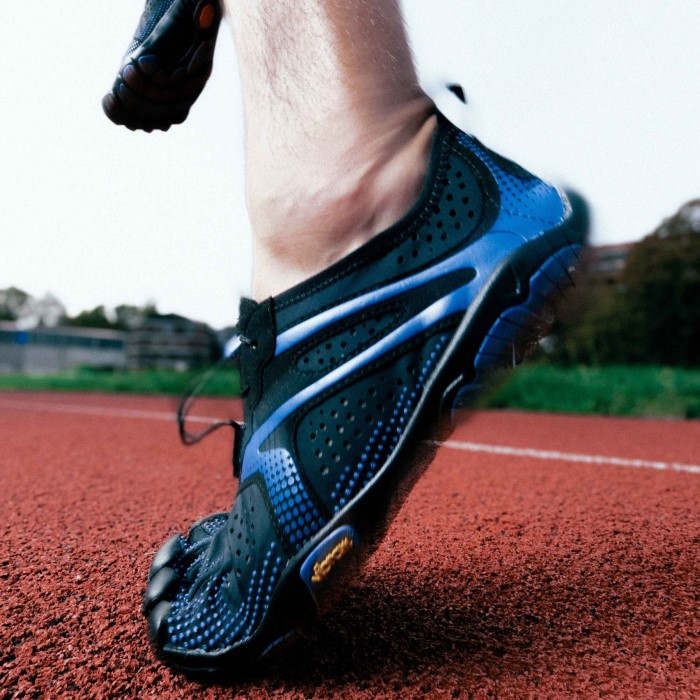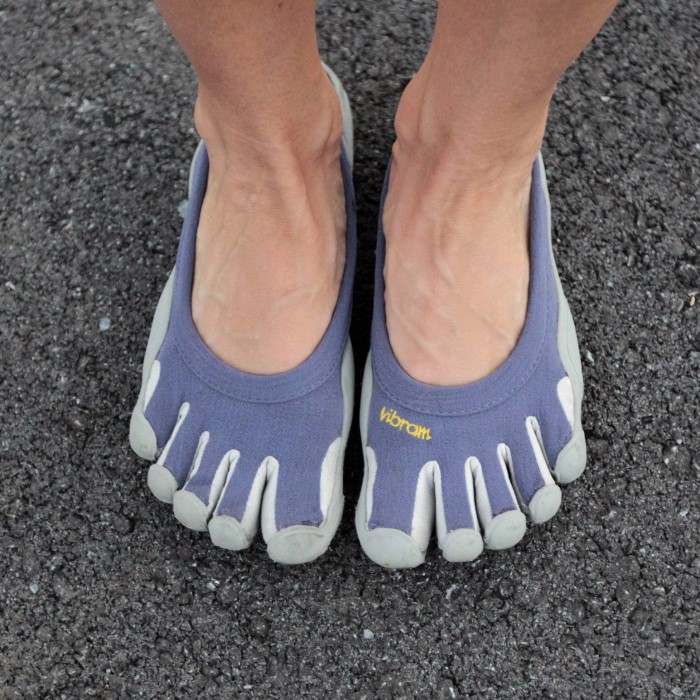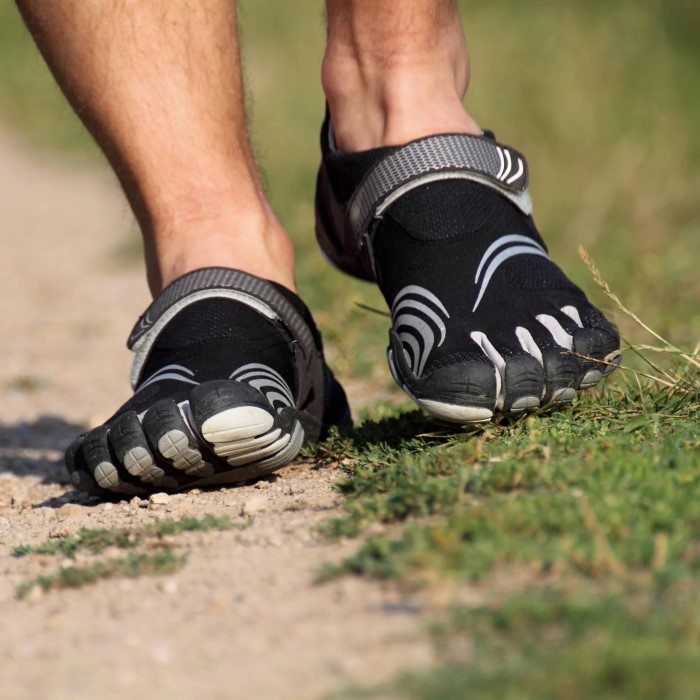What Are Barefoot Running Shoes?
Definition and Key Features
Barefoot running shoes are designed to mimic the natural motion of bare feet. They have thin, flexible soles that offer minimal cushioning. These shoes lack traditional arch support or high heels, allowing for a more natural foot positioning. A key feature is the wide toe box, which helps toes spread naturally.
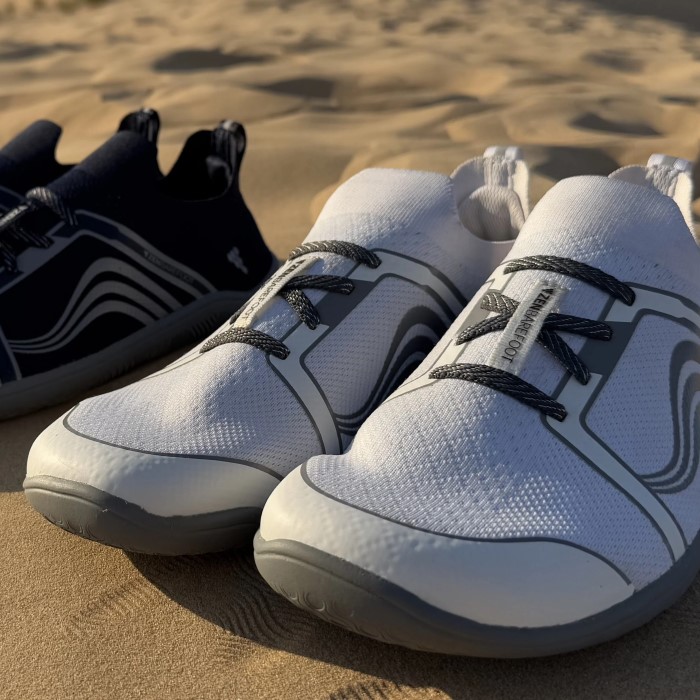
Most barefoot running shoes are lightweight and flexible to promote natural foot movement. They aim to strengthen foot muscles, encourage proper posture, and improve sensory feedback. Unlike traditional footwear, they focus on providing a closer-to-the-ground feel.
How They Differ from Traditional Running Shoes
Barefoot running shoes differ significantly from traditional running shoes in their structure and purpose. Traditional shoes often have thick soles and significant cushioning for shock absorption. They usually include motion control features and arch support for stability.
In contrast, barefoot running shoes focus on a minimalist approach. They have zero or minimal heel-to-toe drop, encouraging a midfoot or forefoot strike rather than a heel strike. Their design emphasizes natural foot function over cushioning and stability control. These differences aim to let your feet move as naturally as possible.
Benefits
Barefoot running shoes offer numerous advantages for runners and fitness enthusiasts. By mimicking natural movement, they promote healthier foot function and overall body mechanics. Let’s explore the top benefits.
Improved Foot Strength and Flexibility
Barefoot running shoes encourage the muscles in your feet to work more actively. Without the support of thick soles, your feet flex naturally during movement. This strengthens the arches, toes, and muscles over time. Flexibility also improves as your feet adapt to this freer motion. Enhanced strength and flexibility reduce pronation issues and support better running posture.
Enhanced Proprioception and Balance
Proprioception is your body’s ability to sense movement and position. Barefoot running shoes enhance sensory feedback by allowing your feet to feel the ground more directly. This sharper awareness improves coordination and stability. Over time, runners experience better balance and agility during workouts or daily activities.
Potential for Reduced Injury Risk
Barefoot running shoes encourage a forefoot or midfoot strike, reducing stress on joints. Traditional heel strikes often lead to injuries like shin splints or knee pain due to excessive impact. Barefoot running shoes promote natural alignment and lower-impact landings. Additionally, they strengthen foot muscles, making them less susceptible to injuries like plantar fasciitis. Regular use may significantly lower the risk of common running-related injuries.
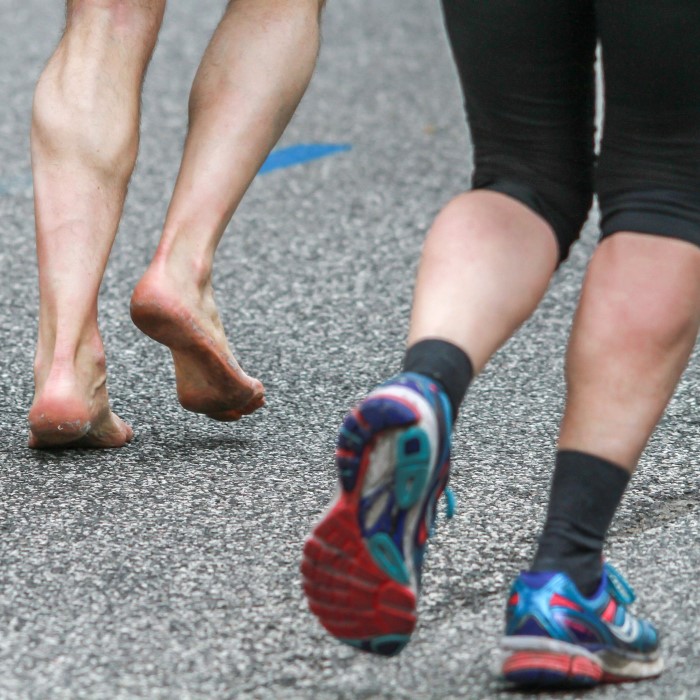
Choosing the Right Barefoot Running Shoes
Choosing the best barefoot running shoes is essential for comfort and performance. With various options available, it’s important to focus on specific factors.
Factors to Consider (Fit, Flexibility, Weight)
- Fit: Ensure the shoes fit snugly but not tightly. They should allow natural toe splay and movement.
- Flexibility: Look for shoes with flexible soles to support natural foot motion. Avoid stiff designs.
- Weight: Opt for lightweight shoes. Heavier options hinder the minimalist benefits of barefoot running shoes.
Evaluate these factors thoroughly before making a purchase. A proper fit ensures comfort and helps minimize foot stress. Flexibility enhances the natural feel, making your runs more efficient. Weight impacts ease of movement and overall performance.
Top Brands and Popular Models
- Vibram FiveFingers: Famous for unique toe separation and ultra-flexible soles. Great for barefoot-like experiences.
- Vivobarefoot: Known for wide toe boxes and thin, durable soles. Ideal for varied terrains.
- Merrell: Offers minimal designs with excellent durability. Perfect for beginner-friendly barefoot footwear.
- Xero Shoes: Lightweight and affordable options. They focus on natural movement and balance.
These brands lead the market in barefoot running shoes. Their designs cater to beginners and experienced runners alike.
Tips for First-Time Buyers
- Start With Softer Terrain: Avoid hard surfaces during your initial runs to prevent foot discomfort.
- Try Before You Buy: Visit a store to ensure proper fit and comfort. Online purchases can be tricky.
- Don’t Rush Transition: Gradually integrate barefoot running shoes into your routine. Wear them casually first.
- Prioritize Comfort Over Style: Focus on finding shoes that match your foot shape and movement needs.
By following these tips, first-time buyers can make informed decisions and enjoy the benefits of barefoot running shoes without complications.
Transitioning to Barefoot Running Shoes Safely
Switching to barefoot running shoes requires care to avoid injuries and gain the full benefits. Gradual adaptation is key to preparing your feet and body for the minimalist design. Let’s explore a step-by-step approach and essential practices for a smooth transition.
Gradual Transition Process
- Start Slowly: Begin by wearing running shoes for short walks or casual outings.
- Limit Initial Runs: Avoid running long distances in these shoes right away.
- Gradual Increase: Slowly increase the duration and intensity of your runs over weeks.
- Alternate Footwear: Mix running shoes with traditional ones during the transition phase.
- Allow Rest Days: Rest your feet regularly to avoid strain and injuries.
Patience is crucial during this process. Rushing can lead to discomfort or injury. Let your feet adapt naturally over time.
Exercises to Strengthen Feet and Ankles
- Toe Curls: Curl your toes repeatedly to strengthen foot muscles.
- Calf Raises: Stand on tiptoes and lower down slowly to build ankle endurance.
- Arch Lifts: Press your toes into the ground to lift your arches.
- Balance Drills: Practice standing on one foot to improve stability.
- Walking Barefoot: Spend time walking barefoot at home to enhance natural movement abilities.
These exercises prepare your feet and ankles for the unique motion running shoes demand, reducing injury risk.
Common Mistakes to Avoid
- Rushing the Transition: Avoid diving into intense runs immediately.
- Skipping Warm-Ups: Always stretch and warm up to prepare your muscles.
- Ignoring Pain: Stop and rest if you experience discomfort during the transition.
- Choosing Incorrect Terrain: Start with softer surfaces like grass instead of concrete.
- Wearing Incorrect Size: Ensure the shoes fit properly to avoid toe or arch distress.
Avoiding these mistakes ensures a safer and more effective transition. Follow best practices and listen to your body to enjoy the benefits of running shoes.
Training Tips
Transitioning to barefoot running shoes is only the first step. To maximize the benefits and avoid injuries, adopting the right training strategies is critical. Here are some practical tips to guide your training process and ensure long-term success.
Building a Beginner-Friendly Training Plan
- Start Small: Begin with short runs of 10–15 minutes to allow your feet to adapt.
- Focus on Frequency: Instead of long runs, practice frequent, shorter sessions to condition your feet.
- Incremental Increase: Increase your running duration by no more than 10% per week to avoid strain.
- Incorporate Rest Days: Give your feet one or two days to recover between runs.
- Cross-Training: Mix in low-impact activities like yoga or swimming to improve muscle balance and flexibility.
A structured training plan enables beginners to gradually strengthen their feet and reduce injury risks.
Adapting to Various Terrains
- Start on Softer Surfaces: Choose grass, trails, or a track to ease the stress on your feet.
- Avoid Uneven Terrain Initially: Steer clear of rocky or uneven paths until your coordination improves.
- Integrate Harder Surfaces Gradually: Introduce roads and pavements slowly over time as your feet grow stronger.
- Be Aware of Weather Conditions: Wet or icy surfaces can be slippery and risky for barefoot running.
- Listen to Your Feet: Adjust your pace and terrain choice based on your comfort level.
Varying terrains helps develop adaptability while keeping your runs safe and enjoyable.
Proper Running Techniques
- Shorten Your Stride: Keep strides short to reduce impact and enhance control.
- Land on Forefoot or Midfoot: Avoid heel strikes to prevent joint stress and injuries.
- Keep Knees Slightly Bent: This adds shock absorption and minimizes strain on the body.
- Maintain Upright Posture: Stand tall with relaxed shoulders and avoid leaning forward excessively.
- Engage Your Core: A strong core supports balance and overall running efficiency.
Proper form not only reduces injury risks but also helps maximize the benefits of barefoot running shoes.
By following these training tips, runners can enjoy a seamless transition and long-term success with barefoot running shoes.
Caring for Your Shoes
Taking good care of your barefoot running shoes is essential for durability and performance. Proper maintenance ensures the shoes last longer and maintain their comfort and functionality.
Cleaning and Maintenance Tips
- Wash Regularly: Clean your barefoot running shoes after every few uses to remove dirt and odors.
- Hand Wash Preferred: Wash the shoes by hand with mild soap and warm water for gentle cleaning.
- Avoid Harsh Chemicals: Use cleaning agents that are safe for fabric and rubber materials.
- Air Dry: Let them dry naturally rather than using a dryer to prevent damage.
- Check for Wear: Inspect the soles and seams regularly for signs of wear or damage.
- Store Properly: Keep your shoes in a dry, cool space to avoid mold or material degradation.
- Use Shoe Shapers: Place shapers or inserts inside to retain their shape when not in use.
Proper cleaning and maintenance protect the shoes’ materials and ensure optimal performance.
When to Replace Your Shoes
- Worn Out Soles: Replace your barefoot running shoes when the soles are smooth and lose grip.
- Tears in Material: Look for tears or deterioration in the upper fabric of the shoes.
- Loss of Flexibility: Replace the shoes if the soles become stiff and unresponsive.
- Reduced Comfort: Discomfort during runs indicates the shoes may need replacing.
- Mileage Rule: Consider replacing your shoes after 300–500 miles, depending on usage frequency.
Recognizing when to replace your barefoot running shoes ensures safety, comfort, and consistent performance.
Common Myths
Barefoot running shoes challenge traditional footwear concepts, leading to many myths and misunderstandings. Let’s address common misconceptions and set realistic expectations.
Dispelling Misconceptions
- Myth: Barefoot Running Shoes Cause More InjuriesReality: Injuries are linked to improper use, not the shoes themselves. Gradual adaptation is key. Poor technique or abrupt transitions may cause strain.
- Myth: They Are Uncomfortable for RunningReality: Barefoot running shoes prioritize natural movement and adapt to your feet over time. Initially, some discomfort may occur, but this decreases as your feet strengthen.
- Myth: Only Professional Runners Should Use ThemReality: Barefoot running shoes suit beginners and experts. They help build foot strength gradually for all.
- Myth: Barefoot Shoes Are Not DurableReality: High-quality models last as long as traditional shoes, especially with proper care. Brands like Vibram and Vivobarefoot focus on durability.
- Myth: They Don’t Provide Any SupportReality: Barefoot running shoes encourage natural foot function but still protect feet from external elements like rocks or debris.
Realistic Expectations
- Improved Foot Health Takes TimeBenefits like stronger foot muscles require consistent use over weeks or months.
- Adapting Requires PatienceTransitioning fully to barefoot shoes may take several weeks. Rushing it can cause discomfort.
- Better Balance and Proprioception Develop GraduallyEnhanced coordination and stability come as your feet adapt to the minimalist design.
- Careful Terrain Choices Are NecessaryNot all surfaces are suitable initially. Gradual integration of harder terrains helps.
- Weight and Flexibility Offer Unique ChallengesLightweight, flexible designs feel different but promote natural movement for long-term benefits.
By dispelling myths and embracing realistic expectations, users can understand and enjoy barefoot running shoes effectively.
Frequently Asked Questions
Are They Suitable for Everyone?
Barefoot running shoes may not be ideal for everyone. They are best suited for individuals who are willing to adapt gradually to their minimalist design. People with strong foot muscles and no severe foot or joint issues might benefit most. If you have medical conditions like flat feet, bunions, or chronic pain, consult a doctor before using them. Proper guidance ensures safe usage and prevents injury concerns. Beginners can also try transitioning slowly to assess comfort and suitability.
Can They Be Used for Other Activities?
Yes, barefoot running shoes are versatile and fit various activities. They are excellent for walking due to their natural movement support. Many users wear them for gym workouts and cross-training. Yoga and Pilates enthusiasts also enjoy their barefoot-like feel. However, they are not ideal for high-impact sports or activities that require extensive foot protection. Activities like hiking on rocky surfaces may require sturdier footwear. Always consider the terrain and demands of the activity before using barefoot running shoes.
Final Thoughts on Barefoot Running Shoes
Barefoot running shoes offer numerous advantages for those looking to enhance their running experience. From improving foot mechanics to preventing injuries, these shoes promote a more natural and engaging running style. As you contemplate making the switch, keep in mind the importance of gradual adaptation, proper shoe selection, and foot care.
By following this guide, you’ll be well-equipped to master your stride and fully enjoy the benefits of running shoes this year. Embrace the freedom of movement, strengthen your feet, and elevate your running experience to new heights. Remember, with the right approach and mindset, you can unlock a new level of running enjoyment and performance.
In conclusion, barefoot running shoes have gained popularity among runners seeking a more natural approach to their sport. With the right preparation and knowledge, you can enjoy the full benefits of this type of footwear. Whether you’re an experienced runner or just starting, consider giving barefoot running shoes a try. Your feet will thank you!
